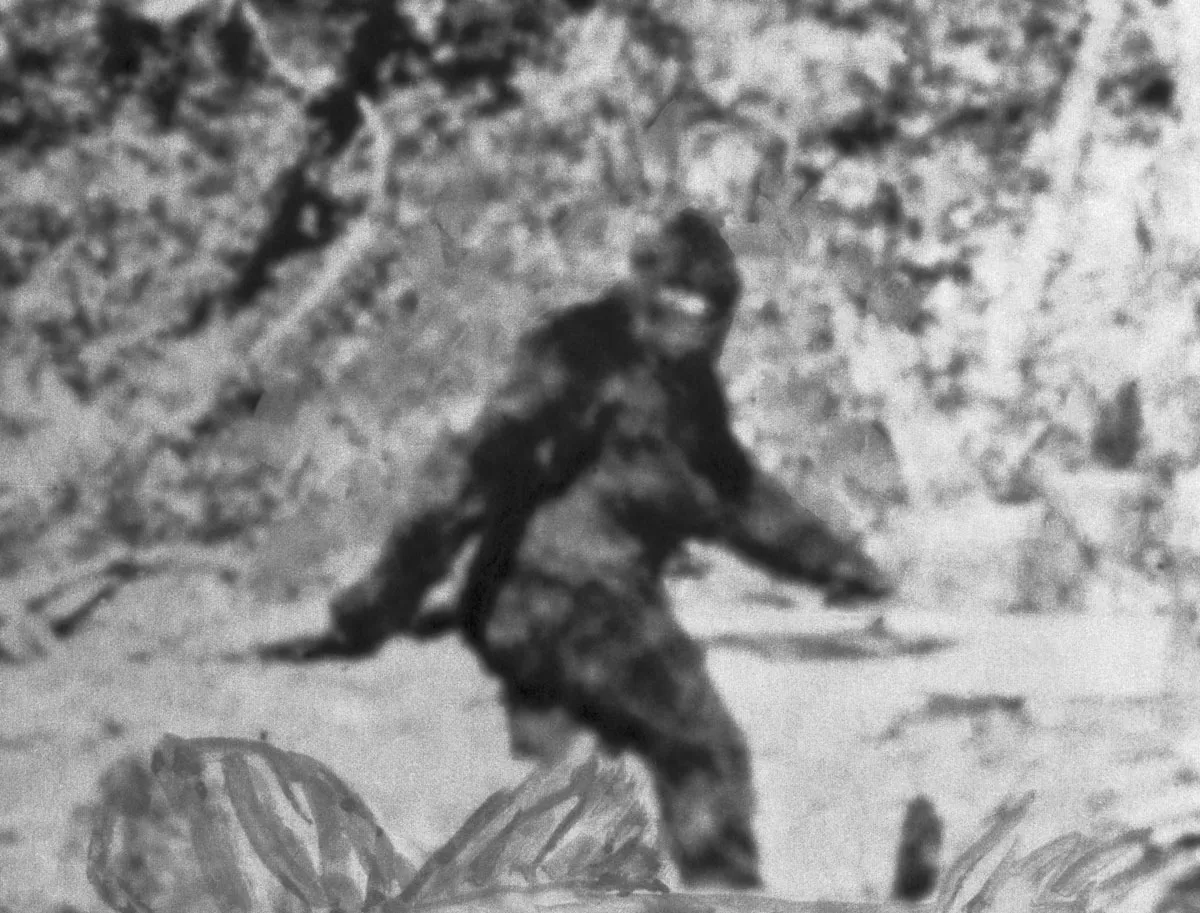Bigfoot is a large, hairy, human-like creature that roams the forests of North America – or so the myths and legends tell us. The Sasquatch is entrenchedinto North American folklore, with many believing they have spotted the mythical beast over the years, just like the Loch Ness Monster.
Take a quick look online and you’ll find countless stories of Bigfoot encounters from the USA and Canada, many of them backed up with video, photographic, and physical 'evidence' from cryptozoologists, including casts of footprints and hair samples. Some have gone further and even claimed Bigfoot is the thought-to-be-extinct relative of the gigantopithecus blacki.
Whatever you think it might be – and whether you believe in the creature or not – there’s no denying the enthusiasm of its hunters and its enduring legacy in pop culture and pseudoscience.
But is Bigfoot real? Here’s everything you need to know about the mythical Sasquatch, from its earliest rumours to its most famous sightings and hoaxes.
Is Bigfoot real?
There is no current definitive evidence Bigfoot is real. Although some people point to supposed video and audio recordings of the Sasquatch, this is not scientific proof of the creature's existence.
Additionally, scientists question the lack of evidence, such as DNA samples or captured specimens. Some propose that misidentifications of known animals, hoaxes, and psychological factors play a significant role in perpetuating the Bigfoot phenomenon.
However, others claim that the mystery surrounding Bigfoot remains unsolved.
What started the Bigfoot rumours?
The first newspaper story about a Bigfoot sighting (a reported capture, no less) was published in the British Columbia Daily Colonist newspaper on 3 July 1882. Still, belief in a giant hairy man-like creature has existed in North America long before that.
In ‘What is a Sasquatch – or, the problematics of reality testing’ published by the Canadian Psychiatric Association Journal, author Louise M Jilek-Aall explains that “the Indians of British Columbia have numerous myths and folk tales about giants inhabiting forests and mountains.”
According to traditional Native American folklore, “the sight of the powerful Sasquatch was apt to cause soul-loss sickness, unconsciousness or upset stomach". Sounds nasty. Stories of the beast have been passed down from generation to generation, some are nicer than others.

The name Sasquatch comes from 'sasq-ets tel', a word from the Sts’ailes indigenous people from British Columbia,Canada. To the Sts’ailes, Sasq'ets Tel is a mountain where the Sasquatch gather, whose people have populated the Harrison River Valley for over 10,000 years. The ‘squatch' is a Bigfoot-like emblem of the Sts’ailes nation and even appears on their flag. To the Sts’ailes, spotting one is a sign of good luck.
Beyond its more traditional roots, others argue the ‘discovery’ of Bigfoot footprints in Bluff Creek, California, by Ray Wallace in 1958 (debunked in 2002 as a hoax following the prankster's death) and its subsequent write-up in TRUE Magazine in 1959 popularised the myth, allowing it to enter into the public psyche.
What are some Bigfoot sightings?
There have been many Bigfoot sightings throughout the years, some are more famous than others. The most well-known is the Patterson-Gimlin film from 1967. This grainy footage is supposed to show a female Bigfoot walking in Bluff Creek in Northern California. Yeah, the same Bluff Creek as those Ray Wallace “Bigfoot footprints”.
It’s, well, we’ll let you make your own minds up, but is one major piece of evidence that believers and non-believers both go back to in order to verify or debunk its validity.
Other famous Bigfoot sightings include the Beard Card Provo Canyon clip on YouTube, the Ray Wallace footprints detailed above, and William Roe’s widely reported sighting of a Sasquatch in British Columbia in 1955. Roe wrote an affidavit claiming everything in it to be entirely true.
Roe claims that what he saw “was covered from head to foot with dark brown silver-tipped hair.” He adds that as he watched the creature, he “wondered if some movie company was making a film at this place and that what I saw was an actor, made up to look partly human and partly animal.” There was no film being made there… spooky.
Roe finally adds that “it would be impossible to fake such a specimen.” This is reasoning held by the Bigfoot community to this day.
Is there any solid evidence for Bigfoot?
As of June 2023, there has been no solid evidence pointing to the existence of Bigfoot. We have plenty of anecdotal tales of the mythical creature, supposed video and sound recordings, and more, including casts of feet and hand prints, and hair samples.
In ‘Genetic analysis of hair samples attributed to yeti, Bigfoot and other anomalous primates’, published by Proceedings of the Royal Society B biological research journal, scientists in the world’s first systematic genetic survey “used rigorous decontamination followed by mitochondrial 12S RNA sequencing to identify the species origin of 30 hair samples attributed to anomalous primates.”
In their findings, they noted that aside from two samples, “none of the submitted and analysed hair samples returned a sequence that could not be matched with an extant mammalian species, often a domesticate [a farm animal].”
The two more mysterious hair samples, from an animal shot in India, and what was supposedly a nest of yeti in Bhutan, “had a 100 per cent match with DNA recovered from a Pleistocene fossil more than 40,000 BP of U. maritimus [polar bear] but not to modern examples of the species.”
The report details how it “seems more likely that the two hairs reported here are from either a previously unrecognized bear species.”
Whatever the case with those two hairs, it is important to, ahem, bear in mind that absence of evidence is not evidence of absence. You cannot prove something scientifically until you have bona fide proof of its existence.
Have there been any Bigfoot hoaxes?
There have been many Bigfoot hoaxes outed over the years, with the Ray Wallace footprints of 1958 in Bluff Creek example above being one such case.
It’s claimed, too, that the Patterson-Gimlin film in Bluff Creek in 1967, too, was a hoax. According to the Charlotte Observer newspaper, Philip Morris made the suit worn in the Patterson-Gimlin Bigfoot film. The costume creator explains that the film “depicts a man wearing a gorilla suit, which had been hand-sewn in the basement of his Kistler Avenue home.”

According to Morris, Roger Patterson paid “$435 plus shipping and handling for the suit” and even “later called asking how to make it more realistic.” He did this by using “a stick to extend the arms,” brushed the fur “to cover the zipper,” and wore “football pads to make the shoulders bigger".
What’s more, Bob Heironimus has claimed to be the person inside the suit in the video. In ‘Exposing Roger Patterson’s 1967 Bigfoot film hoax’, published by Skeptical Inquirer, Heironimus explains that “Gimlin told me that Roger was going to make a film, and they needed someone to wear a suit.” Needing money at the time, he thought nothing of it.
The report adds that “he was told to stand in one place and not move until Patterson gave him the signal to start walking,” and that his mother, nephew, and two brothers have all confirmed his story.
Read more:
- How do we know that the Loch Ness Monster doesn't exist?
- 'Flying Spaghetti Monster' caught on camera
- 'River monster' first-known dinosaur to have lived in water
Bibliography
‘Gigantopithecus blacki’, Britannica
‘What is a Sasquatch – or, the problematics of reality testing’, Canadian Psychiatric Association Journal, Louise M Jilek-Aall
‘Why do so many people still want to believe in Bigfoot?’, Smithsonian Magazine, September 2018, Ben Crair
‘The strange story of America’s abominable snowman’, TRUE Magazine, December 1959, Ivan T Sanderson
‘William Roe’s 1957 sworn affidavit’, Alberta Sasquatch, May 2019
‘Genetic analysis of hair samples attributed to yeti, Bigfoot and other anomalous primates’, Proceedings of the Royal Society B, August 2014
‘Bigfoot just a big hoax?’, The Charlotte Observer (Internet Archive), May 2004, Tonya Jameson
‘Exposing Roger Patterson’s 1967 Bigfoot film hoax’, Skeptical Inquirer, July/August 2004, Kal K Korff & Michaela Kocis
